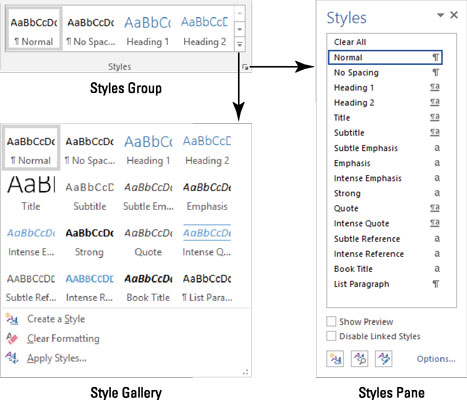The Style Inspector is a pane that shows you the paragraph formatting separated from the textformatting. To open the Style Inspector, do the following:

Word Online

Word Online
The Quick Access Toolbar (QAT) can have a more useful Style menu than the one Microsoft puts on the ribbon. It’s the menu we always have on our QAT. Heading styles and Normal style can get buttons on the QAT. Any other style can also get a QAT button with a bit of extra work. Change 'Select styles to show:' to 'All styles.' Find 'Comment Text' in the list and click it if it’s not already selected. If there are no styles in the list and it’s just a blank white box, click the 'Style Inspector' button at the bottom (the one in the middle with a magnifying glass), and the first item in the smaller box that pops up.
1. On the Home tab, in the Styles group, click thedialog box launcher:
Nov 28, 2016 The Style Inspector (Figure E) separates the two so that direct formatting is easy to spot. To open the Inspector, click the dialog launcher for the Styles group (on the Home tab) and click the. However, this box is not displayed in Office 2013 - to view the paragraph styles I am using, I must go to Styles on the ribbon, click the small icon to open the Styles box and at the bottom I must click the second icon which reveals Style Inspector. The Style Inspector box opens in the Task Pane and although it works well it is huge. You can use styles to quickly apply a set of formatting choices consistently throughout your document. If you want formatting choices that are not available from the built-in styles and themes available in Word, you can modify an existing style and customize it to suit your needs. You can change the formatting (such as font size, color, and text indentation) in styles applied to titles.
2. In the Styles pane, click the Style Inspector button:
Style Inspector Word 2016 Full
In the Style Inspector pane, you can click next buttons:
- Reset to Normal Paragraph Style - Click this button to replace the paragraph's current stylewith the Normal style. (If the paragraph already uses Normal style, clicking thisbutton has no effect.)
- Clear Paragraph Formatting - Click this button to remove any direct formatting that has beenapplied to the paragraph (to restore the paragraph to the formatting contained in its style). Forexample, if someone has changed the line spacing or tabs directly (rather than in style),clicking this button restores them to the style's settings.
- Clear Character Style - Click this button to restore the Default Paragraph Font forthe style. Removing any (or all) character styles like this is often useful.
- Clear Character Formatting - Click this button to remove any direct formatting applied on topof the character style. This has the effect of reapplying the character style. If the characters useDefault Paragraph Font rather than another character style, clicking this button restores thefont formatting in the paragraph style.
- Clear All - Click this button to remove all the formatting and reapply theNormal style.
Click the New Style button to open the larger Create New Style From Formatting dialog box. Click the RevealFormatting button to open the Reveal Formatting pane (see the Reviewthe text formatting quickly using the Reveal Formatting task pane).
See also this tip in French:Utiliser l'Inspecteur de style.
The Style Inspector is a pane that shows you the paragraph formatting separated from the textformatting. To open the Style Inspector, do the following:
Office standard 2013 for mac. 1. On the Home tab, in the Styles group, click thedialog box launcher:
2. In the Styles pane, click the Style Inspector button:
In the Style Inspector pane, you can click next buttons: Watch for mac.
- Reset to Normal Paragraph Style - Click this button to replace the paragraph's current stylewith the Normal style. (If the paragraph already uses Normal style, clicking thisbutton has no effect.)
- Clear Paragraph Formatting - Click this button to remove any direct formatting that has beenapplied to the paragraph (to restore the paragraph to the formatting contained in its style). Forexample, if someone has changed the line spacing or tabs directly (rather than in style),clicking this button restores them to the style's settings.
- Clear Character Style - Click this button to restore the Default Paragraph Font forthe style. Removing any (or all) character styles like this is often useful.
- Clear Character Formatting - Click this button to remove any direct formatting applied on topof the character style. This has the effect of reapplying the character style. If the characters useDefault Paragraph Font rather than another character style, clicking this button restores thefont formatting in the paragraph style.
- Clear All - Click this button to remove all the formatting and reapply theNormal style.
Click the New Style button to open the larger Create New Style From Formatting dialog box. Click the RevealFormatting button to open the Reveal Formatting pane (see the Reviewthe text formatting quickly using the Reveal Formatting task pane).
See also this tip in French:Utiliser l'Inspecteur de style.
